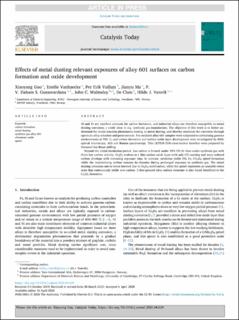| dc.contributor.author | Guo, Xiaoyang | |
| dc.contributor.author | Vanhaecke, Estelle Marie M. | |
| dc.contributor.author | Vullum, Per Erik | |
| dc.contributor.author | Ma, Jianyu | |
| dc.contributor.author | Panditha Vidana, Daham Sanjaya Gunawardana | |
| dc.contributor.author | Walmsley, John | |
| dc.contributor.author | Chen, De | |
| dc.contributor.author | Venvik, Hilde Johnsen | |
| dc.date.accessioned | 2022-05-09T07:04:57Z | |
| dc.date.available | 2022-05-09T07:04:57Z | |
| dc.date.created | 2021-01-05T18:24:16Z | |
| dc.date.issued | 2020 | |
| dc.identifier.citation | Catalysis Today. 2020 (369), 48-61. | en_US |
| dc.identifier.issn | 0920-5861 | |
| dc.identifier.uri | https://hdl.handle.net/11250/2994655 | |
| dc.description.abstract | Ni and Fe are excellent catalysts for carbon formation, and industrial alloys are therefore susceptible to metal dusting corrosion; a costly issue in e.g. synthesis gas manufacture. The objective of this work is to better understand the initial reaction phenomena leading to metal dusting, and thereby minimize the corrosion through optimum alloy selection and pretreatment. Pre-oxidized alloy 601 samples were subjected to carburizing gaseous environments at 750 °C, and carbon formation and surface oxide layer development were investigated by SEM, optical microscopy, AES and Raman spectroscopy. Thin (S)TEM/EDS cross-section lamellae were prepared by Focussed Ion Beam milling. Beyond the initial incubation period, less carbon is formed under 10% CO/Ar than under synthesis gas with finite low carbon activity. Cr2O3 evolves as a thin surface oxide layer with only CO reacting and more ordered carbon develops with increasing exposure time. In contrast, oxidation yields (Ni, Fe, Cr)3O4 spinel formation while the materializing carbon remains its disorder during prolonged exposure to synthesis gas. The metal dusting corrosion rate is hence lowered due to Cr2O3 stabilization, while the spinel represents an unstable redox state that continuously yields new carbon. A fine-grained alloy surface structure is also found beneficial to the Cr2O3 formation. | en_US |
| dc.language.iso | eng | en_US |
| dc.publisher | Elsevier | en_US |
| dc.rights | Navngivelse 4.0 Internasjonal | * |
| dc.rights.uri | http://creativecommons.org/licenses/by/4.0/deed.no | * |
| dc.subject | spinel | en_US |
| dc.subject | chromium oxide | en_US |
| dc.subject | synthesis gas alloy 601 | en_US |
| dc.subject | metal dusting | en_US |
| dc.subject | carbon formation | en_US |
| dc.title | Effects of metal dusting relevant exposures of alloy 601 surfaces on carbon formation and oxide development | en_US |
| dc.type | Peer reviewed | en_US |
| dc.type | Journal article | en_US |
| dc.description.version | publishedVersion | en_US |
| dc.rights.holder | © 2020 The Author(s). Published by Elsevier B.V. | en_US |
| dc.source.pagenumber | 48-61 | en_US |
| dc.source.volume | 369 | en_US |
| dc.source.journal | Catalysis Today | en_US |
| dc.identifier.doi | 10.1016/j.cattod.2020.04.029 | |
| dc.identifier.cristin | 1865964 | |
| cristin.ispublished | true | |
| cristin.fulltext | original | |
| cristin.qualitycode | 2 | |

